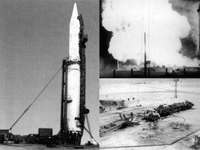R-16 explosion: Biggest disaster in Soviet rocket technology
 Mourning ceremonies took place on Sunday, October 24th, at Baikonur spaceport in Kazakhstan and in the units of Russian military space forces to mark the 50th anniversary since the largest catastrophe in the Russian rocket technology. R-16 rocket exploded on its launch pad on October 24, 1960, 30 minutes before launch. Up to 126 people were killed in the explosion.
Mourning ceremonies took place on Sunday, October 24th, at Baikonur spaceport in Kazakhstan and in the units of Russian military space forces to mark the 50th anniversary since the largest catastrophe in the Russian rocket technology. R-16 rocket exploded on its launch pad on October 24, 1960, 30 minutes before launch. Up to 126 people were killed in the explosion.

The details of the tragedy were classified; the Soviet administration did not acknowledge the event until 1989. In 1985, it was reported that it was the human factor that made the explosion occur. The nation was getting ready to celebrate November 7 (the Day of the Great October Revolution). The test of the R-16 intercontinental rocket was supposed to become another major achievement for the rocket technology of the USSR. Military officials and space industry engineers were in a hurry, but as it turned out - haste makes waste indeed.
The Communist Party administration immediately took efforts to conceal the information about the tragedy from the general public. The details of the disaster were hidden in a special dossier of the Central Committee of the Communist Party. The dossier has been subsequently declassified: it is currently being stored in the Archives of the Russian President.
In the West, the tragedy was dubbed as the Nedelin catastrophe, in honor of Mitrofan Nedelin, the curator of the project, who became one of the victims of the explosion. It is worthy of note that the R-16 explosion killed most prominent scientists of the Soviet rocket-building industry.
The R-16 intercontinental ballistic missile blew up 30 minutes before its maiden launch. The official death toll was 78, but estimates are as high as 150, with 120 being the generally accepted figure.
The missile was over 30 m long, 3.0 m in diameter and had a launch weight of 141 tons. The rocket was fueled with Devil's Venom - hypergolic UDMH-nitric acid - which is used in rocketry despite the fact that it is an extremely corrosive, extremely toxic and extremely effective binary fuel, that produces poisonous gas when burned. These risks were accounted for in the safety procedures in preparing the rocket for launching, but, late that day, technicians accidentally ruptured the pyrotechnic membranes of the first-stage fuel lines and allowed the fuel into the combustion chamber.
Although that was not immediately dangerous, the fuel's nitric acid component was so corrosive it could not be in the fuel lines for more than two days without seriously damaging the R-16 rocket. Thus, the rocket team had either to launch the next day or drain the fuel from the rocket and then rebuild the engine, and so delay the program several weeks. The rocketeers decided to fire the rocket and accelerated preparations. Several other rocket components were tested that day and either replaced or adjusted per procedure.
The rocket's on-board batteries had been powered and connected, and the safety blocks had been disabled in the course of testing. The re-setting of the PCD opened the pyrotechnic valves and fired the second stage engines of the rocket.
The second stage engines fired immediately. The flames cut into the first-stage fuel tanks below and they exploded. Automatically-activated cinema cameras set around the launching pad filmed the explosion. People near the rocket were instantly incinerated; those farther away were burned to death or poisoned by the resulting toxic gases. As soon as the engines were fired, most of the personnel there ran to the perimeter but were trapped in it by the security fence and then engulfed in the fireball of burning fuel. Nedelin and 125 other rocket personnel were killed.
It took pathologists weeks to identify the killed. Marshal Nedelin was identified on his Hero of the Soviet Union decoration which did not melt in the fire.
Nedelin was buried underneath the Kremlin wall. Fifty-six military men were buried in a common grave on the territory of Baikonur. Rocket engineers and designers were buried quietly, according to places of their residence. Officials of the Communist Party administration decided not to expose their cause of death.
Andrey Mikhailov
Pravda.Ru
Subscribe to Pravda.Ru Telegram channel, Facebook, RSS!


